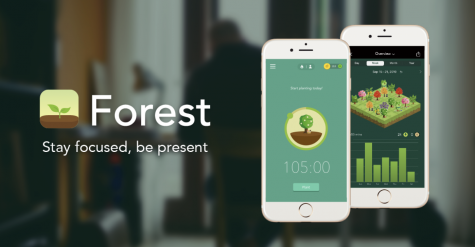5 Ways to Make Social Media More Positive

This is part of a series of stories aimed at examining the role social media plays in the lives of teenagers.
December 7, 2021
According to the Addiction Center, social media has a similar chemical reaction in the brain as cocaine. They compared it to a “syringe of dopamine being injected straight into the system.”
Social media is listed as a behavioral addiction, driven by the urge to open up social media applications, and distracting the users from more important things in their lives.
They estimate that “as many as 5 to 10% of Americans meet the criteria for social media addiction today.”
Because social media is so addicting, it can be hard to put the phone down, even after learning how harmful it can be to our mental health.
Social media is not going to disappear, and it’s unlikely the majority of its users are going to delete all media applications. So, the solution to the toxic social media issue is doing our best to make the platforms more positive.
1. Limit your screen time
Too much of anything can be dangerous. The more you’re on social media, the more you’re exposing yourself to potentially toxic or triggering content.
Limiting screen time is easier said than done. People get bored, decide to go on their phone for a short amount of time, then get wrapped up in an endless cycle of scrolling.
One option is using the limits on screen time you can control in your settings. However, I personally did this and just ended up turning them off when I went past the time limit.
In place of screen time settings, I downloaded an app called Forest. You can choose anytime between 10 minutes and two hours, depending on how long you need to stay focused, and a tree will grow. They will be added to your collection in the app. 
If you unlock your phone during the duration of the time limit you sent, your tree will die. The dead tree will be shown in your collection with the rest of the forest.
I think it’s extremely helpful to be able to see your progress with limiting your screen time in a bigger picture. It’s also unsatisfying to have a bunch of green trees with one dead one sticking out, which motivates me to not use my phone.
2. Put less stress on what you post
As much as we hate to admit it, the majority of us are far too worried with what we put out on Instagram, VSCO, or TikTok.
For example, Instagram used to be a fun light hearted app to share your favorite photos. However, now people stress over captions, editing, feed aesthetic, comments, likes, and even what time we post so their photo can “do well.”
I’ve had Instagram since 2013. Up until about 2016, I would post every photo I took that captured a fun time with friends, or something that made me happy. After that point, I stopped posting photos that weren’t “Instagram worthy,” even if I liked them.
Similar to screen time, even if we are aware of the toxic stress we are putting on our posts, we continue to strive for the perfect feed.
Limiting the pressure and stress associated with posting will not happen right away, nor is it a one person job.
Next time you’re hesitant to post a photo on Instagram because you’re worried about how well the photo will do, I encourage you to click the upload button and stop worrying about it. As cheesy as it sounds, instead of posting pictures that build a facade of a perfect life for others to see, put yourself first and post those that make positive memories last longer.
Another small change you can make to ease the stress on social media is turning your Instagram “likes” off. It’s a minuscule thing, requiring no effort or negative repercussions, that can make a big difference.
If we all do this, social media, especially Instagram, will slowly but surely become more fun and less of a highlight-reel of only our best moments.
3. Choose the right apps to spend your time on
I’m sure we can all agree that some social media apps are more toxic than others. More recently, TikTok and its infamous algorithm has been a large topic of discussion regarding toxic content that feeds insecurities
Instead of using social media to fantasize over an often fake lifestyle that the algorithm creates for us, it would benefit all of us to use social media to connect with others.
Apps like Snapchat can be really powerful if used the right way. One of the best outcomes of the invention of social media is the doors it opens in terms of communication.
If you’re going to go on your phone, make the time valuable; don’t waste it on endless scrolling. Catch up with a friend, and when you’re done, put the phone down.
We, however, still need to act on recommendation number one and limit the time we spend on these apps, even if it’s spent talking to friends.
4. Don’t open your phone first thing in the morning
When the alarm goes off, for many of us, our first instinct is to grab our phones. It’s a habit to check Instagram, Tik Tok, and Snapchat, to see what we could’ve missed when we were sleeping.
Forbes explains the science behind waking up and immediately looking at your phone. This habit causes the brain to skip two important stages of the mind, the Theta and Alpha stage.
Scientific American found that “the ideation that can take place during the theta state is often free flow and occurs without censorship or guilt.”
Picking up your phone not only causes you to be wide awake right away, your mind skips this key creative state, and it creates avoidable stress from the minute the day starts.
There is also the risk of being exposed to triggering or stressful content. It’s easy to see how waking up at 7 am and seeing people on TikTok post about anything from politics to body image could make someone anxious or insecure throughout the day.
Instead, save the time to check your feed for when your mind is wide awake and prepared to take in information
5. Spread Positivity!
My final piece of advice is by far the easiest way to transform your experience on social media. In fact, I think a lot of us already do a really good job at this.
It never hurts to comment something nice on someone’s post, and it could mean a lot to the person on the other side of the phone. If not on a post, reach out to a friend, make plans. Use the available social media tools to connect and build relationships.
Social media is most likely here for the long haul, so why wouldn’t we want to use it positively? Starting small and implicating one of these steps at a time will slowly make social media a more positive experience.






